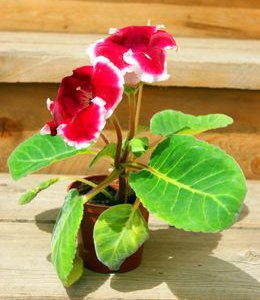Gloxinia plant which is of the species of 'Sinningia speciosa', is a beautiful plant that bears bright, bell-shaped flowers. Here are instructions on growing this plant.
 Sinningia speciosa
Sinningia speciosa, commonly known as gloxinia plant is a tuberous member of the flowering plant family
gesneriaceae. It is also called florist's gloxinia to distinguish it from other species that fall under the genus
gloxinia. It produces very large flowers which are bright, bell shaped, with a velvety texture. This plant is popular as a houseplant, but can also be planted under non-deciduous trees. This plant is popular as a gift plant and grown alongside African violets and ferns. It makes a beautiful woodland plant or patio container specimen in frost-free gardens during the dry winters.
Light Requirements
Gloxinia houseplants prefer indirect or filtered light through a screen. However, if you are thinking of planting it outdoors, then select a site that receives clouded light which can be under non-deciduous trees or latticed arbors. Early morning or evening light is not harmful for the plant.
Soil Needs
It is often potted in non-organic potting material. But, gloxinia is related to the African violet, so you can use an African violet potting mix too. If you are planning to grow it using dormant tuber roots then sow them in a moist and well-drained soil. For containers, use a soil containing peat and perlite. While for outdoor gardening, choose soil which is slightly acidic or has a neutral pH. Ideally, sandy soil with organic composting matter should be used.
Fertilizer Requirements
The plant should be fertilized every month with a water-soluble fertilizer for blooming plants like Miracle Grow or fertilizers similar to it. Another alternative to this fertilizer is a slow-releasing, granular fertilizer which can be applied annually during early spring.
Temperature Needs
These plants need warm nighttime temperature which can be between 65 to 70 degrees Fahrenheit, along with high humidity and good ventilation. The temperature during day time should be 10 degrees warmer. You can place the plant on a tray of moist gravel, or keep misting over the new plants.
Watering Instructions
Drench the soil and let it become moderately dry, after each watering session. Reduce water amount during winter and dormant season. If you are using rainwater, then make sure it is not acidic.
Pruning and Propagation Tips
For pruning the plant, cut the spend flowers at the base of the stem and be careful with the leaves which are brittle and damage easily. For a new plant, remove a healthy stem from the plant and make a 45 degrees cut on the stem. Then stick the stem into a light and porous potting soil mix and maintain the soil moist, but not overly wet otherwise it will rot. Place the potted plant in a bright and cool location, away from direct sunlight. It will take four to five months before you will be able to transplant the new plant.
If the above instructions are followed properly, then the plant will not develop diseases or other problems and there will be no need for any pesticides This plant is prone to aphids and scale. Also, monitor the plant for pests like mites, whiteflies, and thrips. Hence, maintain a clean and neat growing environment and use fresh, sterile potting soil to reduce chance of any pests or diseases.






 Sinningia speciosa, commonly known as gloxinia plant is a tuberous member of the flowering plant family gesneriaceae. It is also called florist's gloxinia to distinguish it from other species that fall under the genus gloxinia. It produces very large flowers which are bright, bell shaped, with a velvety texture. This plant is popular as a houseplant, but can also be planted under non-deciduous trees. This plant is popular as a gift plant and grown alongside African violets and ferns. It makes a beautiful woodland plant or patio container specimen in frost-free gardens during the dry winters.
Sinningia speciosa, commonly known as gloxinia plant is a tuberous member of the flowering plant family gesneriaceae. It is also called florist's gloxinia to distinguish it from other species that fall under the genus gloxinia. It produces very large flowers which are bright, bell shaped, with a velvety texture. This plant is popular as a houseplant, but can also be planted under non-deciduous trees. This plant is popular as a gift plant and grown alongside African violets and ferns. It makes a beautiful woodland plant or patio container specimen in frost-free gardens during the dry winters.